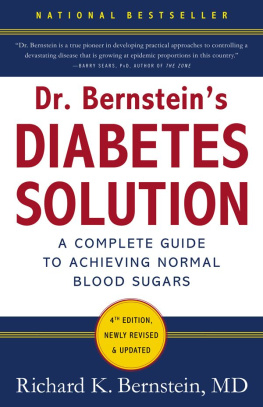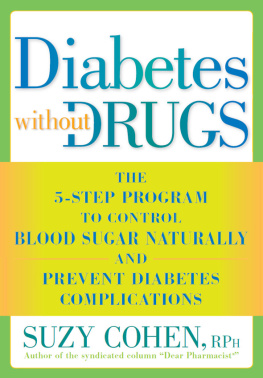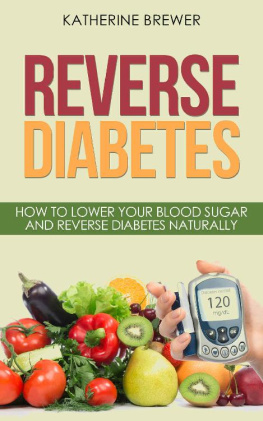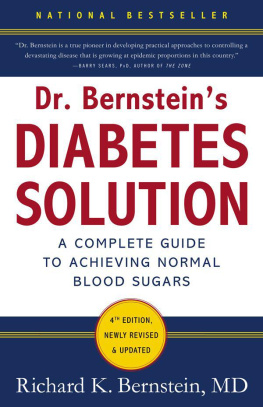Dr. Bernstein's
Diabetes Solution
Newly Revised and Updated
THE COMPLETE GUIDE
TO ACHIEVING NORMAL BLOOD SUGARS
Richard K. Bernstein, MD,
FACE, FACN, FCCWS
Foreword by Frank Vinicor, MD, MPH
Recipes by Karen A. Weinstock and Timothy J.Aubert, CWC

LITTLE, BROWN AND COMPANY
NEW YORK BOSTON LONDON
This book is not intended as a substitute for professional medical care. The reader should regularly consult a physician for all health-related problems and routine care.
I'm sharing this book to save lives.The actual recommendation are killing millions per year with their high carbs diet supported by various lobbies and pharmaceutical companies. But It is changing slowly. The ADA (American Diabetes Association) has recognized that a low carb. diet is suitable for weight loss and is even a legitimate diet since 2013 amongst other ones. Many people in third world countries cannot afford to pay a book. And Dr Bernstein is quite old 82 years in 2016 and was fighting alone during many decades. I know that sharing it is illegal. If you disapprove that method, please do not read any further. If you have found this book helpful, please show your gratitude by buying it on Amazon.com for around 10 dollars in 2016.
Theories, no matter how pertinent,
Cannot eradicate the existence of facts.
Jean Martin Charcot
Dedicated to the Memory of
My Dear Friends Heinz I. Lippmann, MD,
Ephraim Friedman, MD,
and
Samuel M. Rosen, MD,
who fervently believed that people with diabetes are entitled to the same blood sugars as nondiabetics
by Frank Vinicor, MD, MPH
Former Director, Division of Diabetes Translation
National Center for Chronic Disease Prevention and Health Promotion
Centers for Disease Control and Prevention
Atlanta, Georgia
W e are learning a lot about diabetesespecially during the past five years. This accumulation of new knowledge is both encouraging and at the same time very challenging. On the challenging side:
Diabetes seems to be everywhere and steadily increasing in its presence. Think about it1 in 3 babies born in 2000 will develop diabetes in their lifetimes. Every day, about 1,400 people are diagnosed with diabetes in the United States. And now no country in the world is free from diabetes, and its growth.
We now do know how to prevent type 2 diabetes, but today for type 1 diabetes, neither prevention nor a long-lasting cure is available.
Once diabetes is present, good care based on solid science now can prevent much of the devastation formerly caused by elevated blood sugars. But there remains a sizable gap between what we know to do and how well and widely we are doing it. In other words, the translation of diabetes science into daily practice still has a way to go.
Nonetheless, in spite of these and other important challenges, we are all better prepared to deal with diabetes in 2011 than we were even a few years ago, let alone decades ago. Remarkable progress has occurred. For example, many people at high risk for type 2 diabetes do not develop it. Modest weight loss and increased physical activity have been shown to eliminate or at least delay the development of this type of diabetes by 6070 percentregardless of race, ethnicity, or age.
In addition, for both types 1 and 2 diabetes, we now have many more effective medications which, when taken appropriately and in combination with proper nutrition and activity, will result in controlled plasma glucose, blood pressure, and blood fatswith definite reduction in the likelihood of eye, kidney, nerve, and heart problems. In other words, while the goals of diabetes research still in large part should be prevention or cure, even now the devastation formerly caused by this condition does not have to happen!
Nowadays, too, we have better ways to follow and keep track of diabeteswith improved health care systems, better educational programs, less painful self-monitoring of blood sugars, more quickly available and accurate glycated hemoglobin levels, ways to identify kidney problems early, and so forth. We can know what is going on!
So, in fact, we are actually seeing an improvement in diabetes care in the United States, although not with all people and not yet to an adequate level or fast enough.
What does all this have to do with Dr. Bernstein and this edition of Diabetes Solution? As mentioned earlier, the rate of accumulation of new diabetes knowledge is quite remarkable and daunting. Yet Dr. Bernstein stays on top of it all. The care pattern for diabetes has become much more complex and demanding, and Dr. Bernstein and his approach have proved equal to the challenge. In essence, diabetes is in many ways less easy than in the pastfor the patient and for his or her health care professional. There are lots of nutritional approaches to consider, lots of medications to be used in varying combination, and often less time within a busy office practice to make all these wonderful advances real and meaningful for people facing diabetes. This newly revised edition presents the advances in diabetes thinking and management with passion, compassion, caring, and conviction. Certainly, for some people, his approaches are not easy! But they do reflect evolving medical science as well as his personal experiences in managing his own diabetes. He does not ask anyone to do anything that he himself would not do, and for this I have respect and admiration. He is offering to persons challenged by the presence or risk of diabetes a way to be in charge of the disease. And he is ensuring that important advances in diabetes science get out there now to make a difference in peoples lives. Take a look! Think about the ideas and suggestionsthey can further our mutual and ongoing effort to prevent, capture, and control this disease called diabetes.
S ince the publication of the previous edition of Dr. Bernsteins Diabetes Solution in 2007, many new developments have occurred in the field of diabetes research, and as each significant one has come along, I have further refined my techniques for normalizing blood sugars. This newly revised and updated edition discusses new medications, new insulins, new dietary supplements, new hardware (tools for the diabetic), and other new products. It also explores new methods that I have developed for more elegantly controlling blood sugars.
Exciting new approaches to weight loss will be found here, including the use of new, injectable medications (incretin mimetics) that are wonderfully effective for alleviating carbohydrate craving and overeating.
This newly revised and updated edition builds upon the prior three editions of this book and upon my three earlier books about diabetes. It is designed as a tool for patients to be used under the guidance of their physicians or diabetes educators. It covers, in a step-by-step fashion, virtually everything that must be done to keep blood sugars in the normal range.
In these pages I attempt to present nearly everything I know about blood sugar normalization, how it can be accomplished and maintained. With this book, and with the help of your physician or diabetes educator, I hope that you will learn to take control of your diabetes, whether its type 1 (juvenile-onset), as mine is, or the much more common type 2 (maturity-onset) diabetes. To my knowledge, there is no other book in print addressed strictly to blood sugar control for both types of diabetes.
This volume contains much material that may be new to many physicians treating diabetes. It is my hope that doctors and health care professionals will use it, learn from it, and do their best to help their patients take control of this potentially deadly but controllable disease.









